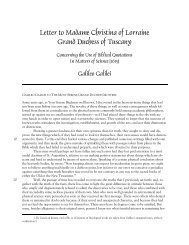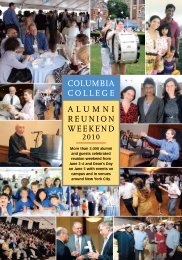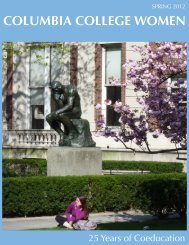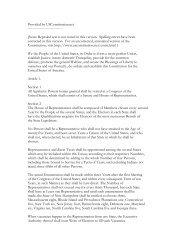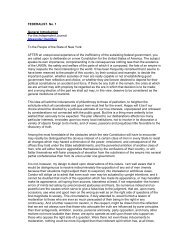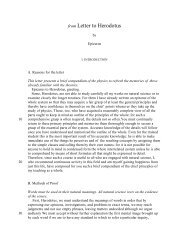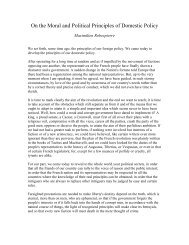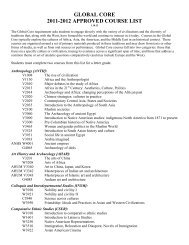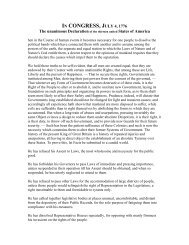Download this issue as a PDF - Columbia College - Columbia ...
Download this issue as a PDF - Columbia College - Columbia ...
Download this issue as a PDF - Columbia College - Columbia ...
You also want an ePaper? Increase the reach of your titles
YUMPU automatically turns print PDFs into web optimized ePapers that Google loves.
RICHARD HEFFNER ’46<br />
COLUMBIA COLLEGE TODAY<br />
COLUMBIA COLLEGE TODAY RICHARD HEFFNER ’46<br />
nearly struck when an engineer accidentally wiped the tape but<br />
Heffner w<strong>as</strong> able to sit down with her again, <strong>this</strong> time at the Park<br />
Central Hotel in Manhattan. “Instead of hearing the chimes of the<br />
clock in the background and the fireplace, you heard cars going<br />
from first gear into second and then third, 17 stories below.”<br />
Street noise notwithstanding, the effort went over well and<br />
WMCA gave Heffner a syndicated weekly half-hour program, History<br />
in the News. Even before the show had finished its run though,<br />
toward the end of 1954, Heffner w<strong>as</strong> looking ahead. Through California<br />
Gov. Earl Warren — the father of one of his students at Berkeley<br />
— he met Edward R. Murrow, whose signature sign-off, “Good<br />
night and good luck,” Heffner still uses to conclude Open Mind.<br />
“Murrow liked me. He immediately called Stuart Novins, the<br />
head of CBS radio news. Novins offered me a job <strong>as</strong> a producer at<br />
CBS News. And I said — here is the ham in me — ‘Can I be on the<br />
air, also?’ And he said no. And I said, ‘Thanks, but I want to be on<br />
the air.’ Maybe it w<strong>as</strong> stupid. Maybe I would be president of CBS<br />
News today.”<br />
In the end, he got his way. WRCA-TV, the predecessor to NBC,<br />
gave him Man of the Year, a public affairs show, in 1955. That led to<br />
All About Men-All About Women and Of Men and Ide<strong>as</strong>, <strong>as</strong> well <strong>as</strong> radio<br />
stints with Listen, Listen, Listen and Collector’s Item. But The Open<br />
Mind, which originally aired on WRCA, remains the sine qua non of<br />
Heffner’s broadc<strong>as</strong>t life, the product of a fundamental realization.<br />
“We’re talking about 1956,” Heffner says. “America had real<br />
problems. But they were laid over with c<strong>as</strong>h and comfort of the<br />
wonderful suburban ’50s. I had the feeling that there were comparatively<br />
few places where Americans were confronted with<br />
important exchanges about important challenges that faced us,<br />
and that’s what I wanted to be doing.”<br />
Soon enough, Open Mind w<strong>as</strong> delving into such hot-button are<strong>as</strong><br />
<strong>as</strong> alcoholism, integration, homosexuality, anti-Semitism and blacklisting<br />
— so much so that a 1956 Newsday column w<strong>as</strong> headlined<br />
“Open Mind Moderator Denies Show Seeks Sensational Topics.”<br />
But if the subjects were controversial, the guests were stellar.<br />
In the decades that followed, they have included Margaret Mead<br />
’23 Barnard, ’29 GSAS; Joseph Heller; Martin Luther King Jr.; Max<br />
Frankel ’52, ’ 53 GSAS; Robert Redford; Max Lerner; Isaac Asimov<br />
’39, ’41 GSAS; Gloria Steinem; Rod Serling; Norman Cousins ’37<br />
TC; Eli Wallach; Ruth Westheimer ’70 TC; and Malcolm X.<br />
In 1959, CBS chairman William S. Paley appointed Heffner<br />
secretary of the network’s editorial board, “whipping the<br />
owned-and-operated CBS television and radio stations into<br />
doing editorials on a local level,” <strong>as</strong> Heffner says. Though his<br />
power to set guidelines and write the editorials made him “very,<br />
very unpopular” among station managers, he did not suffer their<br />
disple<strong>as</strong>ure for long. Within a year he became a special consultant<br />
to the National Educational Television and Radio Center, which<br />
led to his being named general manager of New York’s first public<br />
television station, WNDT, the forerunner of today’s WNET.<br />
For NETRC, the e<strong>as</strong>y part about organizing the n<strong>as</strong>cent station<br />
w<strong>as</strong> raising the necessary $6.2 million in seed money. Rather<br />
more difficult w<strong>as</strong> actually getting on the air. At the time, all seven<br />
coveted VHF stations in the New York area were already in use.<br />
So with the approval of the Federal Communications Commission,<br />
NETRC purch<strong>as</strong>ed station WNTA, Channel 13, in Newark<br />
— much to the consternation of New Jersey Gov. Robert Meyner,<br />
who sued in federal court to block the takeover.<br />
“Meyner w<strong>as</strong> a strange man,” Heffner recalls. “He said, ‘You<br />
are raping the sovereign state of New Jersey. You are taking its only<br />
VHF station.’ And it w<strong>as</strong> perfectly true. But it w<strong>as</strong> a bankrupt station.<br />
It w<strong>as</strong> a distress sale, because it owed so much money.”<br />
Once the sale cleared, and the purch<strong>as</strong>ers incorporated <strong>as</strong> the<br />
Educational Broadc<strong>as</strong>ting Corp. (EBC), Heffner began a “pretty<br />
goddamned busy, pretty goddamned exciting” ph<strong>as</strong>e of his life<br />
<strong>as</strong> WNDT went on the air on September 16, 1962. Often working<br />
from 6 a.m. until midnight, Heffner dealt with staff <strong>issue</strong>s,<br />
logistics, budgets, programming and the occ<strong>as</strong>ional emergency<br />
— like when hordes of parents howled after he canceled a festival<br />
of previously unaired Charlie Chaplin films in favor of coverage<br />
of the Cuban missile crisis.<br />
Not surprisingly, he w<strong>as</strong> shattered when EBC fired him the<br />
following April amid conflicts over policy and the very nature of<br />
what w<strong>as</strong> then called “educational television.” Heffner favored a<br />
wide range of programming, especially expensive cultural fare;<br />
EBC, led by president Sam Gould, envisioned WNDT <strong>as</strong> a cheaper<br />
cl<strong>as</strong>sroom of the air, specializing in instructional programs. The<br />
New York Times covered the developing drama on its front page;<br />
some 50 non-union WNDT staff members offered to take a 10<br />
percent pay cut to retain their boss.<br />
“I’m a teacher. I’m a talker. I’m a speaker.<br />
I’m a preacher. That’s who I am.”<br />
As WNET prepares to celebrate its 50th anniversary <strong>this</strong> fall,<br />
the memory still stings. “As you can imagine, having spent those<br />
years in making a reality of something that had been a dream of<br />
mine. … How did I feel when suddenly the ground w<strong>as</strong> pulled<br />
out from under me? Godawful.”<br />
But the morning after he w<strong>as</strong> sacked, Rutgers president M<strong>as</strong>on<br />
Gross called and offered him a tenured faculty position; today,<br />
he is the University Professor of Communications and Public<br />
Policy. A few days later, pollster Elmo Roper provided him with a<br />
secretary, an office and an appointment with AT&T.<br />
“He said, ‘You have lunch with them, respond to their questions,<br />
and be yourself.’ I went down, had a very nice — though<br />
institutional — lunch and gave them some advice on communications<br />
matters they thought terribly pressing. I came back, went<br />
into Elmo’s office and said, ‘OK, Elmo, what do I do now?’ And<br />
Elmo said, ‘Send them an invoice for $10,000.’”<br />
It w<strong>as</strong> the beginning of the consulting firm Richard Heffner Associates,<br />
whose clients came to include Time, American Airlines<br />
and the American Association for the Advancement of Science.<br />
Heffner often quotes John Milton’s Areopagitica: “Who<br />
ever knew Truth put to the worse, in a free and open<br />
encounter?” But having spent decades in the trenches,<br />
Heffner also knows how the world works. A good<br />
example occurred in 1987, when Judge Wachtler <strong>as</strong>ked him to<br />
chair a commission to determine whether camer<strong>as</strong> should be permitted<br />
in New York state courtrooms. Years before the spectacle<br />
of Court TV and the O.J. Simpson trial, Heffner said no, concluding<br />
that networks would simply pluck juicy bits out of context.<br />
“They were eager to put on the air attractive, sensational materials<br />
from trials. They were not eager to teach lessons.”<br />
In 1974, he got an even more bracing lesson<br />
in media reality, when he w<strong>as</strong> named<br />
chairman of the Cl<strong>as</strong>sification and Ratings<br />
Administration (CARA) of the Motion Picture<br />
Association of America at the personal<br />
request of its president, Jack Valenti. Before<br />
long, he had become what the Los Angeles<br />
Times called “the le<strong>as</strong>t known, most powerful<br />
man in Hollywood.” As such, he w<strong>as</strong><br />
at the center of major ratings controversies<br />
over the violence in such movies <strong>as</strong> Cruising<br />
and Scarface (directed by Brian De Palma<br />
’62); at one point he cl<strong>as</strong>hed with United<br />
Artists chairman Arthur Krim ’30, ’32L<br />
about Rollerball. Heffner felt it should be rated<br />
“X,” prompting Krim to thunder, “This<br />
man’s predecessor w<strong>as</strong> a fanatic about sex;<br />
<strong>this</strong> man is a fanatic about violence!”<br />
Heffner enjoyed many <strong>as</strong>pects of the<br />
job, though. As he told film critic Charles<br />
Champlin in an exhaustive series of interviews<br />
for the <strong>Columbia</strong> Center for Oral History,<br />
“There were times when the picture<br />
w<strong>as</strong> over and I would say to my colleagues,<br />
‘You know, <strong>this</strong> really makes it all worthwhile.’<br />
And I meant it.”<br />
But there w<strong>as</strong> also endless wrangling with Valenti and industry<br />
professionals who often cajoled, persuaded or pressured Heffner<br />
and his board to <strong>as</strong>sign a family-friendly “PG,” rather than an “R”<br />
or a dreaded “X.” Almost weekly, Heffner commuted to and from<br />
California to screen movies and meet with the board, refusing to<br />
move there because he feared that constant socializing with actors<br />
and directors would corrupt his integrity.<br />
Not long after he w<strong>as</strong> appointed, Heffner began to suggest<br />
to Valenti — “always with the utmost politeness” — ways of<br />
improving the system. He especially wanted to provide better<br />
ratings explanations and more fully fleshed out guidelines to<br />
distinguish between younger and older teenagers. At one point,<br />
he pushed for an “RR” category between “R” and “X,” signaling<br />
that the content w<strong>as</strong>, <strong>as</strong> he put it, “really rough.” In the end, “PG-<br />
13” w<strong>as</strong> added in 1984 and “NC-17” supplanted “X” in 1990.<br />
By the time he stepped down in 1994, Heffner had grave<br />
doubts about the effectiveness of the self-imposed system. Immediately<br />
upon leaving CARA, he became a senior fellow at the<br />
Freedom Forum, at that time located on campus at the Journalism<br />
School. In the year that followed, Heffner attempted to sort<br />
out and put on paper the lessons he had learned in Hollywood<br />
(or, <strong>as</strong> he put it, “in GaGaLand”). He remains conflicted about<br />
voluntary ratings for films and, by extension, for TV shows, recordings<br />
and video games.<br />
But he is convinced of one thing at le<strong>as</strong>t, probably much to<br />
the distress of his friend Abrams: “In a society so largely b<strong>as</strong>ed<br />
upon free speech and free thought, and in a society that is <strong>as</strong><br />
much b<strong>as</strong>ed upon the almighty dollar <strong>as</strong> ours is, a larger degree<br />
of regulation is necessary.”<br />
Every Saturday at noon — except during pledge weeks<br />
— viewers can tune to Channel 13 and be greeted by the<br />
sight of two simple, intersecting human profiles with<br />
brain-shaped holes cut in them, slowly revolving amid<br />
the eerie strains of World Without Time by the Sauter [<strong>as</strong> in Edward<br />
Sauter ’36]-Finegan Orchestra. Although graphic designer<br />
Heffner studies his notes in preparation for a taping of The Open Mind.<br />
PHOTO: RANDY MONCEAUX<br />
Lee Moss designed Open Mind’s iconic logo, it w<strong>as</strong> Heffner who<br />
chose the accompanying theme, which he describes <strong>as</strong> “mental<br />
health music.”<br />
How much longer will it continue? At 87, Heffner is hardly<br />
unaware of his mortality; he h<strong>as</strong> even spoken with Alexander, his<br />
grandson, about taking over the program. Open Mind, however,<br />
is not just another venue for talking heads; its roster of guests and<br />
topics, its low-key, probing, intellectual give-and-take, constitutes<br />
a personal expression of the host himself.<br />
Indeed, from 1959–67, when Heffner w<strong>as</strong> busy with various<br />
ventures and put the Princeton historian Eric Goldman in the moderator’s<br />
chair in his stead, he w<strong>as</strong> unhappy with the result. He felt<br />
that Goldman, a cultural adviser to the White House, w<strong>as</strong> pushing<br />
a political agenda with the show. “He used his invitations to<br />
feather the nest of the Johnson administration. As far <strong>as</strong> I w<strong>as</strong> concerned,<br />
they weren’t The Open Mind. That’s why, now, I’m much<br />
more honest about it. I call it Richard Heffner’s Open Mind. It’s not<br />
anyone else’s.<br />
“How long I’ll be able to keep doing it, or how long my voice<br />
or my mind will l<strong>as</strong>t — who knows?” he says, lounging in the<br />
book-crammed study in his Riverside Drive apartment, his dog<br />
C<strong>as</strong>sie resting on the couch. “Would I like to continue? Yes. I’d<br />
like to continue to the point at which I know I’m no longer doing<br />
what I did and others also feel that way. Then I hope I have the<br />
good grace to say, ‘Good night and good luck’ a final time.<br />
“Sure, maybe somebody can do Bill Moyers’ Open Mind, or Alexander<br />
Heffner’s Open Mind, or whatever. But nobody’s going to<br />
do what I did. I am who I am. And that’s all that I am. I’m Popeye<br />
the sailor man.”<br />
He smiles and looks semi-serious. “Remember that.”<br />
Former <strong>Columbia</strong> <strong>College</strong> Today acting editor Thom<strong>as</strong> Vinciguerra<br />
’85, ’86J, ’90 GSAS is executive editor of This Week From Indian<br />
Country Today, a regular contributor to The New York Times and<br />
the editor of Backward Ran Sentences: The Best of Wolcott Gibbs<br />
from The New Yorker.<br />
FALL 2012<br />
38<br />
FALL 2012<br />
39




